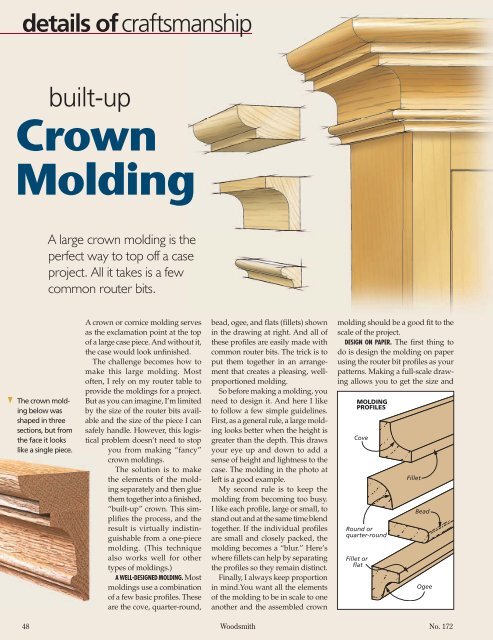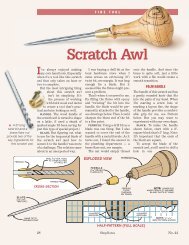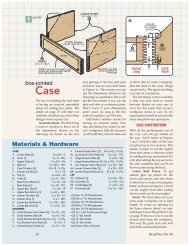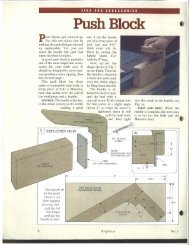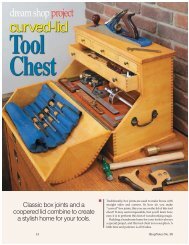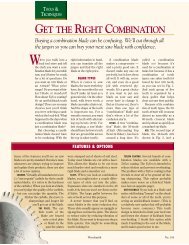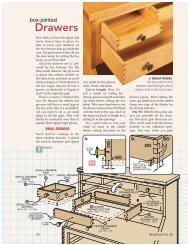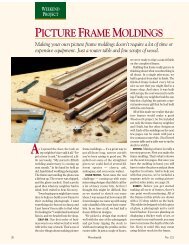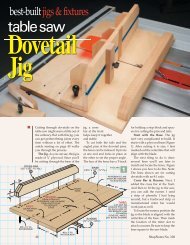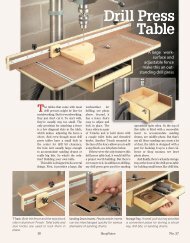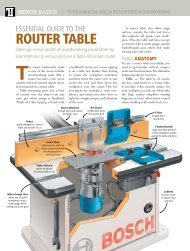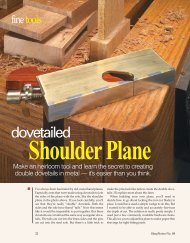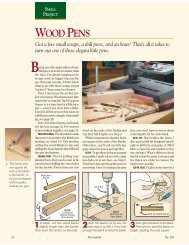Built-up Crown Molding - Woodsmith Woodworking Seminars
Built-up Crown Molding - Woodsmith Woodworking Seminars
Built-up Crown Molding - Woodsmith Woodworking Seminars
You also want an ePaper? Increase the reach of your titles
YUMPU automatically turns print PDFs into web optimized ePapers that Google loves.
details of craftsmanshipbuilt-<strong>up</strong><strong>Crown</strong><strong>Molding</strong>A large crown molding is theperfect way to top off a caseproject. All it takes is a fewcommon router bits.} The crown moldingbelow wasshaped in threesections, but fromthe face it lookslike a single piece.A crown or cornice molding servesas the exclamation point at the topof a large case piece. And without it,the case would look unfinished.The challenge becomes how tomake this large molding. Mostoften, I rely on my router table toprovide the moldings for a project.But as you can imagine, I’m limitedby the size of the router bits availableand the size of the piece I cansafely handle. However, this logisticalproblem doesn’t need to stopyou from making “fancy”crown moldings.The solution is to makethe elements of the moldingseparately and then gluethem together into a finished,“built-<strong>up</strong>” crown. This simplifiesthe process, and theresult is virtually indistinguishablefrom a one-piecemolding. (This techniquealso works well for othertypes of moldings.)A WELL-DESIGNED MOLDING. Mostmoldings use a combinationof a few basic profiles. Theseare the cove, quarter-round,bead, ogee, and flats (fillets) shownin the drawing at right. And all ofthese profiles are easily made withcommon router bits. The trick is toput them together in an arrangementthat creates a pleasing, wellproportionedmolding.So before making a molding, youneed to design it. And here I liketo follow a few simple guidelines.First, as a general rule, a large moldinglooks better when the height isgreater than the depth. This drawsyour eye <strong>up</strong> and down to add asense of height and lightness to thecase. The molding in the photo atleft is a good example.My second rule is to keep themolding from becoming too busy.I like each profile, large or small, tostand out and at the same time blendtogether. If the individual profilesare small and closely packed, themolding becomes a “blur.” Here’swhere fillets can help by separatingthe profiles so they remain distinct.Finally, I always keep proportionin mind.You want all the elementsof the molding to be in scale to oneanother and the assembled crownmolding should be a good fit to thescale of the project.DESIGN ON PAPER. The first thing todo is design the molding on paperusing the router bit profiles as yourpatterns. Making a full-scale drawingallows you to get the size and48 <strong>Woodsmith</strong> No. 172
proportions right. And you can seehow the individual pieces can beassembled to make the molding.The molding shown on the oppositepage follows all the rules andmakes a good example of how to“build” a crown molding. As youcan see, it’s made in three sections.First comes a small, “bead andcove” profile that ties it to the cabinetand makes a smooth transition.Then, a large, simple cove section isused to add height and depth. Thecap, separated from the cove by fillets,is simply a roundover that endssharply to punctuate the crown.MATCH YOUR WOOD. Before talkingtechnique, I should mention a wordabout wood selection. The idea isto make the molding appear as if itwere all one piece. So you want topay attention to the color and grainmatch of the individual pieces.Whenever possible, it’s a goodplan to cut all the sections from oneboard. If necessary, you can use thepieces in different orientations —edge grain, or face grain. The routedprofiles do a good job of hiding anychange in grain direction.MAKING THE CROWNOnce you’ve designed the molding,the work is pretty routine. To makethe crown molding shown, I startedwith the large cove section.The top drawing at right showsthe process. The profile is cut witha 5 ⁄ 8 "-rad. cove bit. Elongating thecut creates the illusion of a largerradius. This is simply a matter ofcutting the cove to full width, thenraising the bit to extend the cut intothe workpiece. The bottom sectionactually ends <strong>up</strong> being flat, but the<strong>up</strong>per rounded section of the coveis what catches your eye.To do the work safely, I startedwith a wide piece of 1"-thick stock.This leaves you with plenty of surfaceriding against the fence as thecove cut is extended. When completed,the cove section is cut toheight on the table saw.A BEAD AND COVE. Next comes thesmall bead and cove piece that sitsbelow the large cove. The beadstands proud of the bottom edge ofthe large cove to add depth.Again, this small molding is madeon the edge of an oversized piece ofstock. The two middle drawings atright show the two steps involved.First, I cut the bead first with a singlepass across a beading bit. (Youcould also use a 1 ⁄ 8 " roundover bit tocut the bead in two halves.) Whencutting the bead, you’ll also createthe short fillet below that separatesthe bead and cove.The cove is routed with a 1 ⁄ 2 "-dia.core box bit. Just make sure to leaveat least a 1 ⁄ 16 " fillet separating theprofiles. Then I ripped the moldingfree, leaving it a little extra-wide tomake the final assembly easier.A SIMPLE ROUNDOVER. The top “cap”is routed on a wide piece with a 1 ⁄ 2 "roundover bit. You want the arc ofthe roundover to end sharply. Thisgives you a crisp end point at thetop of the molding, as shown inthe lower drawing at right. It alsoleaves a wide fillet along the loweredge of the piece that — when combinedwith the cove section below— adds a “stairstep” detail.ASSEMBLY. Once all the pieces aremade, the goal of the assemblyis two-fold — the molded edgesshould be aligned properly, andyou want the glue joints to be tight.The best way to get this done is toglue <strong>up</strong> only two pieces at a time.a.a.a.a.The keys to the glue<strong>up</strong> are plentyof clamps, cauls to distribute theclamping pressure, and a minimumamount of glue. There will bevery little stress on the glue joint, sostrength isn’t a big concern. I spreadthe glue sparingly, keeping it to theback edge of the joint and then let ittack <strong>up</strong> for a minute. Then align themolded edges (don’t worry aboutthe back face) and clamp the pieces,making sure they stay in place.Once the glue<strong>up</strong> is complete, theback face can be trimmed flush atthe table saw or jointer. And onceit’s installed on your project, onlyyou will know the secret of your“pieced” crown molding. Wwww.<strong>Woodsmith</strong>.com <strong>Woodsmith</strong> 49


